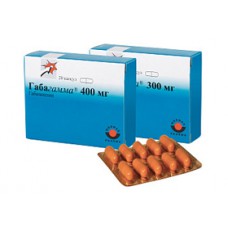Expiration date: 09/2026
Structure and Composition:
Solid gelatine capsules. One capsule contains Gabapentin 300 or 400 mg
Excipients: lactose, corn starch, gelatin, talc, titanium dioxide, iron oxide yellow iron oxide red
in blister 10 pcs. a stack of cardboard 2, 5 and 10 blisters.
Description pharmaceutical form:
300 mg capsules: Hard gelatin capsules ?1 yellow.
400 mg capsules: Hard gelatin capsules orange.
The contents of the capsule: white powder.
Pharmacokinetics:
The bioavailability of gabapentin is not proportional to dose. Thus, by increasing the dose is reduced. After oral administration, Cmax of gabapentin in plasma achieved in 2-3 hours. The absolute bioavailability of gabapentin capsules is approximately 60%. Foods including with a high content of fat, it has no effect on pharmacokinetics. Excretion of gabapentin plasma is best described by a linear model. T1 / 2 of the plasma is independent of dose and averages 5-7 hours. Pharmacokinetics unchanged with repeated use of the equilibrium concentration in the plasma can be predicted on the basis of the results of a single dose. Gabapentin is almost bound to plasma proteins (<3%) and has a volume of distribution of 57.7 liters. Displays only the kidneys in an unmodified form, does not undergo metabolism. The drug does not induce liver oxidative enzymes mixed function involved in the metabolism of drugs. Clearance from plasma gabapentin reduced in the elderly and patients with impaired renal function. The constant rate of excretion, clearance from the plasma and renal clearance are directly proportional to creatinine clearance. Gabapentin is removed from plasma by hemodialysis. In patients with impaired renal function and patients receiving hemodialysis, dose adjustment is recommended (see. "Dosage and administration").
Description of the pharmacological actions:
Gabapentin is structurally similar to the neurotransmitter GABA but its mechanism of action is different from other drugs that interact with GABA-receptors (valproate, barbiturates, benzodiazepines, GABA transaminase inhibitors, GABA reuptake inhibitors, GABA agonists, prodrugs of GABA). It has no GABAergic properties and no effect on GABA capture and metabolism. Preliminary studies showed that gabapentin is associated with & alpha2 - & delta-subunit voltazhzavisimyh calcium channel and reduces the flow of calcium ions, which plays an important role in the onset of neuropathic pain. Other mechanisms of action of gabapentin for neuropathic pain are glutamatzavisimoy reduction in neuronal death, increasing the synthesis of GABA, inhibition of monoamine neurotransmitter release group. Gabapentin at clinically relevant concentrations, does not bind to receptors of other drugs or neurotransmitters, including GABA receptors, GABA B, benzodiazepine, glutamate, glycine, or N-methyl-d- aspartate. Unlike phenytoin and carbamazepine, gabapentin does not interact with sodium channels in vitro. Gabapentin partially attenuated effects glutamate receptor agonist N-methyl-d-aspartate in some tests in vitro, but only at a concentration of more than 100 micromoles, which is not achieved in vivo. Gabapentin slightly reduces the release of monoamine neurotransmitters in vitro.
Indications:
- complex therapy of partial seizures with secondary generalization and without adults and children from 12 years
- pain in diabetic neuropathy
- postherpetic neuralgia in adults.
Contraindications:
- hypersensitivity to any component of the drug
- acute pancreatitis
- hereditary galactose deficiency
- lactase deficiency
- glucose-galactose malabsorption.
Carefully:
- renal insufficiency (see. "Dosage and administration")
- psychotic diseases.
Application of pregnancy and breastfeeding:
There are no data on the use of the drug in pregnant women, therefore, gabapentin should be used during pregnancy only if the expected benefit to the mother outweighs the potential risk to the fetus and newborn (congenital malformations, slow mental and physical development).
Gabapentin is excreted in breast milk, so during treatment should abandon breastfeeding.
Side effect:
Cardiovascular system: symptoms of vasodilation or increased blood pressure, palpitations.
Digestive system: flatulence, anorexia, gingivitis, abdominal pain, constipation, dental disease, diarrhea, dyspepsia, increased appetite, dry mouth or throat, nausea, vomiting, dental disease, increase in liver transaminases, hepatitis, jaundice, pancreatitis.
blood system, lymphatic system: purpura (often it is described as bruising, occurred when a physical injury), leukopenia, thrombocytopenia.
Musculoskeletal system: arthralgia, back pain, increased fragility of bones, myalgia.
Nervous system: dizziness, headache, hyperkinesia, muscle dyskinesia and dystonia, choreoathetosis, strengthening, weakening or absence of dysarthria reflexes, ataxia, nystagmus, paresthesia, seizures, confusion, fatigue, fatigue, amnesia, depression, abnormal thinking, hostility, emotional lability, insomnia, anxiety, drowsiness, hallucinations.
Respiratory System: pneumonia, bronchitis, shortness of breath, respiratory infections, cough, pharyngitis, rhinitis.
Skin and subcutaneous tissue disorders: acne, skin itching, skin rash, peripheral edema, erythema multiforme exudative (including Stevens-Johnson syndrome).
Urogenital: urinary tract infection, impotence, incontinence, acute renal failure.
Special Senses: blurred vision, amblyopia, diplopia, tinnitus, otitis media.
Other: fever, viral infection, weight gain, lability of blood plasma glucose in patients with diabetes, pain of various localization.
Drug Interactions:
Morphine: by sharing a gabapentin and morphine when morphine was taken 2 hours prior to gabapentin, the increase observed average AUC of gabapentin by 44% compared to a monotherapy gabapentin that was associated with an increase in pain threshold (KHOLODOVA pressor test). The clinical significance of this change is not established, the pharmacokinetic characteristics of morphine is not changed. Side effects of morphine during coadministration with gabapentin did not differ from that of morphine when taking in conjunction with the placebo.
The interaction between gabapentin and phenobarbital, phenytoin, carbamazepine and valproic acid were observed. The pharmacokinetics of gabapentin in the equilibrium state is the same in healthy subjects and patients receiving other anticonvulsants.
Concomitant use of gabapentin with oral contraceptives containing norethindrone and / or ethinyl estradiol, was not accompanied by changes in the pharmacokinetics of the two components.
The simultaneous use of gabapentin with antacids that contain aluminum and magnesium, followed by reduction of gabapentin bioavailability by approximately 20%. Gabapentin is recommended to take approximately 2 hours after taking an antacid.
Probenecid does not affect the renal excretion of gabapentin.
A slight decrease in renal excretion of gabapentin while taking cimetidine probably have no clinical significance.
Dosage and administration:
Inside, regardless of meals or with food.
If you need to reduce the dose, stop the drug or replace it with an alternative means, it should be done gradually over a minimum of one week.
Neuropathic pain in adults
The initial dose is 900 mg / day in 3 divided doses equal doses if needed, the dose is gradually increased to the maximum - 3600 mg / day. Treatment may start with a dose of 900 mg / day (300 mg three times a day) or during the first three days, the dose may be increased gradually to 900 mg / day according to the following scheme: Day 1 - 300 mg 1 time at day 2 day - 300 mg 2 times a day 3rd day - 300 mg 3 times a day. It is also possible to use a dosage of 400 mg to patients who are either overweight or above growth medium, similar to the titration of the dosage to 300 mg.
Partial seizures in adults and children from 12 years
Effective dose - from 900 to 3600 mg / day. Therapy can be started with a dose of 300 mg three times a day on the first day and increased gradually to 900 mg according to the scheme described above (see., "Neuropathic pain in adults" section). Subsequently, the dose may be increased up to 3600 mg / day (divided into three equal doses). The maximum interval between doses at 3-fold taking the drug should not exceed 12 hours in order to prevent the resumption of seizures.
There is no need to control the concentration of gabapentin in plasma. It can be used in combination with other anticonvulsants excluding changes in the plasma concentration or the concentration of other antiepileptic drugs in serum.
Selection of doses in renal failure
Patients with renal insufficiency is recommended to decrease the dose of gabapentin according to the table:
| Cl creatinine, ml / min | The daily dose, mg / day (3 doses) |
| >80 | 900–3600 |
| 50–79 | 600–1800 |
| 30–49 | 300–900 |
| 15–29 | 150*–600 |
| <15 | 150*–300 |
* Assign to 300 mg every other day.
The recommendations for patients on hemodialysis
Patients on hemodialysis who had not previously received gabapentin, a drug is recommended to be administered in a saturating dose of 300-400 mg, and then apply it to 200-300 mg every 4 hours of hemodialysis.
Overdose:
Symptoms: dizziness, double vision, impaired speech, drowsiness, lethargy, diarrhea, and increased severity of other side effects.
Treatment: gastric lavage, the appointment of activated charcoal, symptomatic therapy. Patients with severe renal insufficiency, hemodialysis may be indicated.
Special instructions:
Although the syndrome with the development of seizures in the treatment of gabapentin is not checked, however, the abrupt discontinuation of therapy with antiepileptic drugs in patients with partial seizures can induce seizures (see. "Dosage and administration").
Gabapentin is not considered effective in the treatment of absence epilepsy.
In patients who require combination therapy with morphine, may require increased doses of gabapentin. It is necessary to ensure thorough monitoring of patients for the development of such a feature of CNS depression, drowsiness. In this case, the dose of gabapentin or morphine should be reduced appropriately (see. "Interaction with other medicinal products").
Laboratory research. When adding gabapentin with other anticonvulsants were reported false positive results in the determination of protein in urine using test strips Ames N-Multistix SG. For the determination of protein in urine it is recommended to use more specific sulfosalicylic acid precipitation method.
Effects on driving ability and use of technology. Patients should avoid driving, as well as the performance of work requiring speed of psychomotor reactions.





